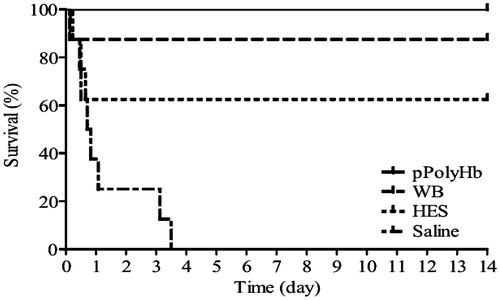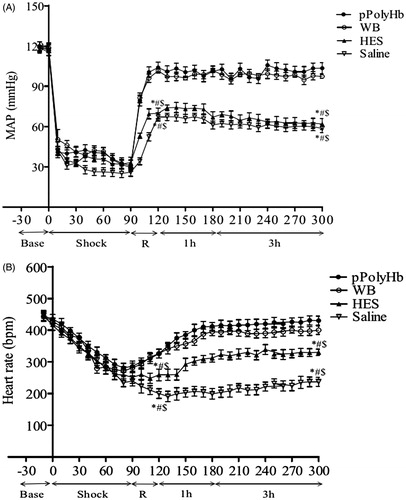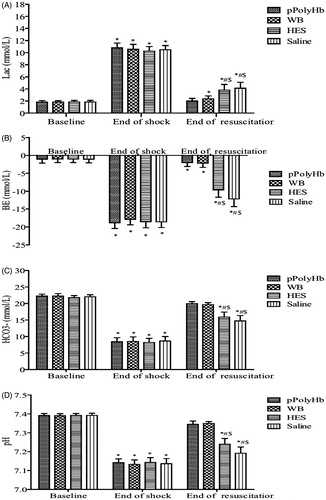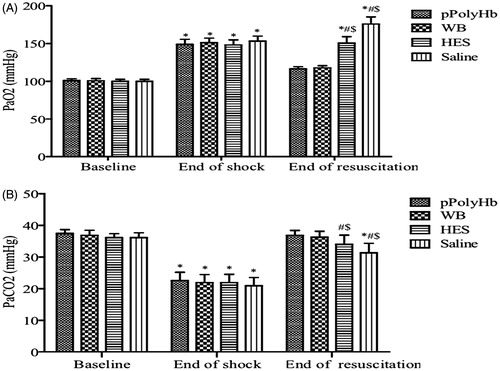Abstract
The objective of this study was to evaluate the effects of polymerized porcine hemoglobin (pPolyHb) on hemodynamic stability and oxygen delivery in a rat model of hemorrhagic shock. Rats underwent controlled hemorrhage, resulting in the loss of 65% of their blood volume in 90 minutes. The results showed that pPolyHb was superior to hetastarch and saline, and similar to whole blood, in restoring hemodynamic stability and reversing anaerobic metabolism caused by hemorrhage. Furthermore, pPolyHb improved oxygen supply and increased blood oxygen content. These data suggest that pPolyHb can be effective in improving tissue perfusion under conditions of severe hemorrhagic shock.
Introduction
Hemorrhagic shock is a pathologic condition in which intravascular volume and tissue oxygen delivery are inadequate, leading to progressive vital organ hypoperfusion, cellular ischemia, and microvascular injury (Elmer et al. Citation2012). The typical signs of shock are low blood pressure, high levels of lactate, decreased urine output, and confusion (Cheung et al. Citation2007). The primary treatment of hemorrhagic shock is to restore blood volume as soon as possible, maintain hemodynamic stability, and tissue perfusion, and improve the supply of oxygen to hypoxic tissues and organs (Jonathan et al. Citation2012). Traditional resuscitation relies on transfusion of crystalloids such as normal saline or lactated Ringer’s, starch-based artificial colloids such as hetastarch or dextrans, or blood components (Cheung et al. Citation2007, Jonathan et al. Citation2012, Sampson et al. Citation2003). These therapies have important roles in the treatment of hemorrhagic shock, but are far from ideal. Previous studies have found that resuscitation with a large quantity of crystalloids was more likely to induce excessive dilution of blood and eventually lead to cellular edema, disturbance of blood coagulation, and the disruption of metabolic function. Compared with crystalloids, resuscitation with starch-based artificial colloids lowers transfusion requirements and decreases physical damage to the tissues. Colloids also have the advantages of better expansion and more efficiency, and thus are preferred for resuscitation in hemorrhagic shock patients. However, several recent studies have reported that hydroxyethyl starch (HES) can cause kidney failure and increase mortality (Brugger et al. Citation2010).
Some promising hemoglobin-based oxygen carriers (HBOCs) have been developed in an attempt to design an ideal resuscitation fluid. HBOCs are chemically modified hemoglobin solutions that can restore blood volume and deliver oxygen to tissues. Jennifer Rice et al. reported results from a swine hemorrhage model (55% estimated blood volume loss) comparing resuscitation with bovine polymerized hemoglobin (HBOC-201) versus hetastarch (HES). In that study, HBOC-201 restored hemodynamics more rapidly, increased transcutaneous oxygen pressure (tcpO2), and decreased blood transfusion requirements, while maintaining cardiac index, oxygen transport, and metabolic parameters (Rice et al. Citation2006). HBOC-201 has been studied in a variety of animal models and has completed phase III human clinical trials (Katz et al. Citation2002, Sprung et al. Citation2002). Another HBOC, human polymerized hemoglobin (PolyHeme, Northfield Laboratories), is a universally compatible oxygen carrier developed to treat life-threatening anemia. When infused at a rate of 6U over 12 h, this product has been shown to increase blood oxygen-carrying capacity and promote survival at life-threatening hemoglobin levels, without the immunoinflammatory effects of stored RBCs (Gould et al. Citation2002, Johnson et al. Citation2003, Moore et al. Citation2009).
Outdated human blood hemoglobin is often used as the main raw material for producing HBOCs (e.g., PolyHeme, Hemolink, and Hemospan) (Gould et al. Citation1998, Leytin et al. Citation2003). However, in less developed countries, there is often insufficient human Hb available to meet demand. Compared with human Hb, animal hemoglobin can be obtained from various sources and there is an abundant supply. The HBOC Hemopure, for example, which has completed phase III human clinical trials, is derived from highly purified bovine hemoglobin. However, bovine hemoglobin has a low affinity for oxygen and may contain prion protein. Polymerized porcine hemoglobin (pPolyHb) uses porcine blood as the raw material due to its high homology with human Hb and freedom from contamination with human viruses (Zhang et al. Citation2012). We have previously demonstrated that pPolyHb can alleviate inflammatory symptoms caused by hemorrhagic shock (Zhu et al. Citation2011b). Additionally, isovolumic exchange transfusion experiments in rats demonstrated that pPolyHb helps maintain hemodynamic stability, enables a suitable level of oxygen delivery to tissues, and effectively reverses anaerobic metabolism caused by extensive blood volume exchange (Zhu et al. Citation2011a).
The experiments described herein extend our previous studies by evaluating the resuscitation effects of pPolyHb. We assess the ability of pPolyHb to maintain hemodynamic stability and adequately deliver oxygen to tissues in comparison with whole blood (WB), hetastarch (HES), and normal saline in a rat model of controlled hemorrhagic shock.
Materials
Reagents
6% Hetastarch 200–0.5 in sodium chloride solution (Fresenius Kabi, Bad Homburg, Germany), pentobarbital sodium (Sigma, St. Louis, MO), Hepalean 1000 U.S.P. units/ml (Organon, Oss, the Netherlands.), sodium chloride (Sigma, St. Louis, MO), potassium chloride (Sigma, St. Louis, MO), calcium chloride (Sigma, St. Louis, MO), sodium phosphate monobasic (Sigma, St. Louis, MO) and disodium hydrogen phosphate (Sigma, St. Louis, MO).
Animals
A total of 32 male Sprague–Dawley rats weighing 200 ± 10 g were provided by Xi, an Jiaotong University Laboratory Animal Center. The experiments described in this study were performed in accordance with the guidelines of the National Institutes of Health on the use of experimental animals. Approval of the Animal Care Committee of Northwest University was obtained prior to initiating the experiments.
Test solutions
pPolyHb (10.5 ± 0.5 g/dl polymerized porcine hemoglobin, methemoglobin <5%, endotoxin <1.0 EU/mL, osmolality 300–330 mOsm, pH 7.4 ± 0.05, average molecular weight of pPolyHb 600 ± 50 kD, 64 kD tetramer <2%) was formulated in buffer consisting of Na+ 135–155 mmol/L, K+ 3.0–5.0 mmol/L, Ca2+ 1–3 mmol/L, Cl- 140–160 mmol/L and stored at 4 °C under nitrogen gas until use.
Methods
Surgical preparation
Male Sprague–Dawley rats (200 ± 10 g, n = 32) were anesthetized with sodium pentobarbital (45 mg/kg, intraperitoneally). The left jugular vein was cannulated (PE 50 tubing) for drug administration. The left femoral artery was cannulated (PE 50 tubing) and connected to a MP150 Data Acquisition System (BIOPAC, Goleta, CA) for recording the blood pressure and heart rate. The right femoral artery was cannulated to induce controlled hemorrhage. The animals were allowed to stabilize for 60 min before starting the experiment. Blood gas analysis was performed on an ABL 800 FLEX (Radiometer, Copenhagen, Denmark).
Hemorrhage and resuscitation protocols
After baseline response measurements, rats were rapidly hemorrhaged by withdrawal of 30 ± 5.0% of the blood volume (BV) via the right femoral artery catheter until the mean arterial pressure (MAP) decreased to 35 ± 5 mmHg (within 10 min). After 10 min of stabilization, rats were intermittently hemorrhaged by 30% removal of their blood volume and maintained hypotensive with a MAP of 35 ± 5 mmHg throughout the hemorrhagic shock period (Bian and Chang Citation2015).
At the end of the 90-min shock period, rats were randomized into 4 resuscitation groups (n = 8): (1) 1.5 g/kg pPolyHb, (2) 1.5 g/kg autologous whole blood, (3) equal amount of HES, and (4) normal saline (NS). Different resuscitation fluids plus twice the lost blood volume of NS were perfused at a rate of 0.5 ml/min through the left jugular vein over 30 min. After a period of observation of 180 min, all catheters were removed and the rats returned to their cages for a further 2 weeks. The surviving rats were sacrificed by barbiturate overdose at the end of the experiment.
Systemic hemodynamic and blood gas parameters
The hemodynamic values, which included mean arterial blood pressure (MAP), heart rate (HR), and respiration rate, were recorded every 10 min throughout the experiment. Blood samples from the femoral artery were collected into heparinized syringes at the following time points: baseline, the end of hemorrhage, the end of resuscitation, and 3 h after resuscitation. Blood gas parameters such as pH, HCO3−, base excess (BE), lactate, and arterial partial pressures of carbon dioxide (PaCO2) and oxygen (PaO2) were tested immediately to monitor real-time physiological changes in the rats.
Statistical analysis
Data are represented as means ± SD for replicate experiments. The differences between treatment groups were assessed by one-way ANOVA followed by unpaired Student’s t-test. Statistical significance was defined as p < 0.05 to reject a null hypothesis. All statistical calculations were performed with JMP version 3.2 for the Macintosh (SAS Institute, Cary, NC).
Results
Life-sustaining ability
Thirty-two animals were subjected to hemorrhage and randomly assigned to the pPolyHb group (n = 8), whole blood group (n = 8), hetastarch group (n = 8), or normal saline group (n = 8). There was no statistically significant difference between the groups in either weights or hemorrhage volume (). shows survival curves for all groups. All rats receiving pPolyHb survived for 2 weeks. Seven rats in the whole blood group survived for 2 weeks, while one animal only lived for 3 h. Six rats in the saline group died within 24 h after resuscitation and only two rats lived for 72 h. Three rats in the HES group died within 24 h after resuscitation, and the rest survived for 2 weeks.
Figure 1. Life-sustaining ability of various resuscitation fluids in a rat hemorrhagic shock model. Rats hemorrhaged 65% of their total blood volume, and then each group (n = 8) received different resuscitation fluids: 1.5 g/kg pPolyHb, 0.6% hetastarch (HES), whole blood (WB), or normal saline (NS), plus twice the lost blood volume of NS. Survival was determined at 1 d intervals starting from the end of infusion of resuscitation fluids.

Table 1. Demographic data and survival times in different groups.
Blood pressure and heart rate
In all animal groups, MAP and HR at baseline were within the normal range, without significant differences across groups (). In response to hemorrhage, MAP rapidly declined to 35 ± 5 mmHg and stayed low during shock in all groups (). By the end of the observation period (3 h), MAP returned to near baseline in the pPolyHb and WB groups, whereas it failed to normalize and the animals remained hypotensive in the HES and saline groups. As shown in , heart rate decreased significantly in all four groups during shock, while it increased and maintained a relatively stable and normal level in the pPolyHb and whole blood groups. These results indicate the superiority of pPolyHb over HES and saline in maintaining hemodynamic stability.
Figure 2. Blood pressure and heart rate in rat hemorrhagic shock model. (A) Mean arterial blood pressure (MAP) and (B) heart rate (HR) were monitored every 10 min throughout the experiment. R: resuscitation. *p < 0.05 in comparison with baseline; #p < 0.05 in comparison with the pPolyHb group; $p < 0.05 in comparison with the WB group.

Table 2. Baseline blood gas parameters in different groups.
Metabolic markers
Lactate (Lac), base excess (BE), and HCO3− are all markers of anaerobic metabolism. These parameters at baseline were within the normal range, without significant differences across groups (). Hemorrhage caused significant metabolic acidosis as evidenced by increased lactate levels and lower levels of BE, pH, and HCO3− at the end of shock (). Infusion of either pPolyHb or WB was able to alleviate metabolic acidosis more effectively than infusion of HES or saline, which is likely due to their effectiveness in oxygen delivery. As shown in , pPolyHb improved BE of the blood following hemorrhage better than either HES or normal saline. Both pH and HCO3− levels () were significantly reduced following hemorrhage, but fully recovered after resuscitation with pPolyHb or WB.
Figure 3. Lactate, base excess (BE), HCO3−, and pH values in hemorrhagic shock model rats. Blood samples were drawn before the start of hemorrhage (baseline), end of shock and end of resuscitation to assess anaerobic metabolism. Blood gas analysis was performed on an ABL 800 (Radiometer, Copenhagen, Denmark). *p < 0.05 in comparison with baseline; #p < 0.05 in comparison with the pPolyHb group; $p < 0.05 in comparison with the WB group. (A) Lactate levels at different periods in rats resuscitated with pPolyHb, WB, HES, or saline. (B) BE levels at different periods in rats resuscitated with pPolyHb, WB, HES, or saline. (C) HCO3 levels at different periods in rats resuscitated with pPolyHb, WB, HES, or saline. (D) pH values at different periods in rats resuscitated with pPolyHb, WB, HES, or saline.

Blood gas analysis
Blood gas parameters are presented in . The level of PaO2 was significantly increased during shock compared with baseline in all groups (). Resuscitation with pPolyHb or WB produced a recovery in PaO2 compared with the other two groups. PaCO2 was reduced following shock due to hyperventilation and the decrease of aerobic metabolism. The PaCO2 level fully recovered after resuscitation with pPolyHb or WB, but remained lower than baseline in the saline group ().
Figure 4. PaO2 and PaCO2 levels in hemorrhagic shock model rats. Blood samples were drawn before the start of hemorrhage (baseline), end of shock, and end of resuscitation to test PaO2 and PaCO2 levels. Blood gas analysis was performed on an ABL 800 (Radiometer, Copenhagen, Denmark). *p < 0.05 in comparison with baseline; #p < 0.05 in comparison with the pPolyHb group; $p < 0.05 in comparison with the WB group. (A) PaO2 levels at different periods in rats resuscitated with pPolyHb, WB, HES, or saline. (B) PaCO2 levels at different periods in rats resuscitated with pPolyHb, WB, HES, or saline.

Discussion
This study was designed to investigate the effectiveness of pPolyHb in maintaining hemodynamic stability and adequately delivering oxygen to tissues in a rat model of hemorrhagic shock. In our previous experiments, pPolyHb used in resuscitation of hemorrhagic shock animals was effective at a minimum dose of 1.5 g/kg. Therefore, the same dose of pPolyHb was used in this current model. Our results confirm that pPolyHb can prolong survival time and improve the survival rate of animals. There was no statistically significant difference in resuscitation ability between pPolyHb and whole blood. However, whole blood has clinical disadvantages because hemolysis or contamination might occur in the process of withdrawing and transfusing autologous blood (Halpem et al. Citation1997), which could increase mortality. The ability of blood-derived products to promote survival in the current model is dependent on their oxygen carrying capacity. HBOCs are expected to restore oxygen supply more effectively than HES and saline after hemorrhagic shock (Standl Citation2001, Winslow Citation2000).
MAP and HR are indicators of the function of the cardiovascular system. An increase in MAP helps to maintain adequate peripheral organ perfusion and attenuate systemic damage caused by hemorrhagic shock. pPolyHb restored and stabilized MAP and HR of rats during both the resuscitation process and the subsequent observation period. These results indicate that pPolyHb provides an effective oxygen supply and volume expansion capability to restore and maintain hemodynamic stability.
Suitable acidity of body fluids is essential for animals to maintain normal physiological activities. Anaerobic metabolism under different study conditions can be analyzed by detecting the change of values for lactate, base excess, and HCO3− in rats with hemorrhagic shock (Hirano et al. Citation2003). Blood gas analysis demonstrated that pPolyHb reduces the level of acidic products such as lactate and restores BE close to the normal value. These findings are consistent with the superior oxygen carrying and releasing capabilities of pPolyHb, which help improve metabolic acidosis.
The clinical significance of arterial oxygen tension (PaO2) is that this measurement is a highly useful and practical method to investigate the degree of tissue hypoxia. PaO2 refers to the comprehensive partial pressure of oxygen in blood, which is made up of inhaled oxygen and the residual oxygen in pulmonary alveoli. The PaO2 level depends both on the partial pressure of inhaled oxygen and on pulmonary respiratory function (Claire and Chris Citation2009). In this study, PaO2 increased during the hemorrhagic period due to the reduction in oxygen carried from the alveoli to other tissues and organs as a result of a decrease in hemoglobin. The restoration of arterial partial pressure of oxygen (PaO2) to baseline values can be attributed to the oxygen-carrying and offloading properties of pPolyHb. pPolyHb has a P50 value of 34–35 mm Hg compared with 26.5 mm Hg for human red blood cells. Therefore, pPolyHb has a lower affinity for oxygen, and more easily releases oxygen to tissues and increases blood oxygen content.
Carbon dioxide partial pressure (PaCO2) is also an important indicator because it is directly related to ventilation and oxygenation. The decrease in plasma PaCO2 seen in all groups after hemorrhage was induced both by the hyperventilation of animals and by the decrease of Hb, causing a significant lowering of the amount of aerobic metabolic product. Infusion of pPolyHb was able to effectively deliver oxygen to the tissues and relieve hyperventilation meanwhile increase plasma PaCO2. This also has been testified by the result of lactate, base excess, and HCO3−. The tissue pCO2 is a valid measurement. It was reported that reinfusion of PolyHb-SOD-CAT-CA could effectively improve deteriorated tissue pCO2 in a rat model with severe hemorrhagic shock (Bian and Chang Citation2015). The effect of infusion with pPolyHb on tissue pCO2 will be investigated in the future study.
Together, these results suggest that the use of pPolyHb in resuscitation following hemorrhagic shock may reduce mortality by maintaining hemodynamic stability and adequate tissue oxygenation. However, additional studies of the effects of pPolyHb resuscitation in other animal models, such as canine, need to be conducted to evaluate the safety and effectiveness of pPolyHb in order to support its use in human clinical trials.
Conclusion
In summary, pPolyHb can effectively maintain hemodynamic stability and deliver oxygen to tissues and organs under conditions of hypoxia and ischemia. In our rat model of hemorrhagic shock, these properties resulted in improved survival rates, effective tissue perfusion, and reversal of anaerobic metabolism. Our present data, combined with previously published papers, suggest that pPolyHb might be a useful therapy for the treatment of hemorrhagic shock in humans.
Funding information
The authors acknowledge with thanks the grants from National High-tech R&D Program (863 Program) (Grant no. 2012AA021902), National Natural Science Foundation of China (Grant no. 81102367), China Scholarship Council of the Ministry of Education as well as grants from Shaanxi Science and Technology Department (Grant nos. 2016SF-243, 2011KTCL03–23 and 2011K12–03-10). This work was also supported by the National Major Scientific and Technological Special Project for “Significant New Drugs Development” (Grant nos. 2014ZX09102043-004).
Disclosure statement
The authors report no conflicts of interest. The authors alone are responsible for the content and writing of this article.
References
- Bian Y, Chang TMS. 2015. A novel nanobiotherapeutic poly-[hemoglobin-superoxide dismutase-catalase-carbonic anhydrase] with no cardiac toxicity for the resuscitation of a rat model with 90 minutes of sustained severe hemorrhagic shock with loss of 2/3 blood volume. Artif Cells Blood Substit Biotechnol. 43:1–9.
- Brugger J, Schick MA, Brock RW, Baumann A, Muellenbach RM, Roewer N, Wunder C. 2010. Carbon monoxide has antioxidative properties in the liver involving P38 map kinase pathway in a murine model of systemic inflammation. Microcirculation. 17:504–513.
- Cheung AT, To PL, Chan DM, Ramanujam S, Barbosa MA, Chen PC, et al. 2007. Comparison of treatment modalities for hemorrhagic shock. Artif Cells Blood Substit Immobil Biotechnol. 35:173–190.
- Claire B, Chris T. 2009. Interpretation of arterial blood gases. Surgery. 27:470–474.
- Elmer J, Alam HB, Wilcox SR. 2012. Hemoglobin-based oxygen carriers for hemorrhagic shock. Resuscitation. 83:285–292.
- Gould SA, Moore EE, Hoyt DB, Burch JM, Haenel JB, Garcia J, DeWoskin R, Moss GS. 1998. The first randomized trial of human polymerized hemoglobin as a blood substitute in acute trauma and emergent surgery. J Am Coll Surg. 187:113–122.
- Gould SA, Moore EE, Hoyt DB, Ness PM, Norris EJ, Carson JL, et al. 2002. The life-sustaining capacity of human polymerized hemoglobin when red cells might be unavailable. J Am Coll Surg. 195:445–455.
- Halpem NA, Alicea M, Seabrook B, Isolyte S. 1997. Aphysiologic multielectrolyte solution, is preferable to normal saline to wash cell saver blood: conclusions from a prospective, randomized study in a canine model. Crit Care Med. 25:1–8.
- Hirano ES, Mantovani M, Morandin RC, Fontelles MJP. 2003. Experimental model of hemorrhagic shock in rat. Acta Cirurgica Bras. 18:465–470.
- Johnson JL, Moore EE, Gonzalez RJ, Fedel N, Partrick DA, Silliman CC. 2003. Alteration of the postinjury hyperinflammatory response by means of resuscitation with a red cell substitute. J Trauma. 54:133–140.
- Jonathan E, Hasan BA, Susan RW. 2012. Hemoglobin-based oxygen carriers for hemorrhagic shock. Resuscitation. 83:285–292.
- Katz LM, Manning JE, McCurdy S, Pearce LB, Gawryl MS, Wang Y, Brown C; Carolina Resuscitation Research Group. 2002. HBOC-201 improves survival in a swine model of hemorrhagic shock and liver injury. Resuscitation. 54:77–87.
- Leytin V, Mazer D, Mody M, Garvey B, Freedman J. 2003. Hemolink, an o-raffinose cross-linked haemoglobin-based oxygen carrier, does not affect activation and function of human platelets in whole blood in vitro. Br J Haematol. 120:535–541.
- Moore EE, Moore FA, Fabian TC, Bernard AC. 2009. Human polymerized hemoglobin for the treatment of hemorrhagic shock when blood is unavailable: the USA multicenter trial. J Am Coll Surg. 208:1–13.
- Rice J, Philbin N, McGwin G, Arnaud F, Johnson T, Flournoy WS, et al. 2006. Bovine polymerized hemoglobin versus Hextend resuscitation in a swine model of severe controlled hemorrhagic shock with delay to definitive care. Shock. 26:302–310.
- Sampson JB, Davis MR, Mueller DL, Kashyap VS, Jenkins DH, Kerby JD. 2003. A comparison of the hemoglobin-based oxygen carrier HBOC-201 to other low-volume resuscitation fluids in a model of controlled hemorrhagic shock. J Trauma. 55:747–754.
- Sprung J, Kindscher JD, Wahr JA, Levy JH, Monk TG, Moritz MW, O'Hara PJ. 2002. The use of bovinehemoglobin glutamer-250 (Hemopure) in surgical patients: results of a multicenter, randomized single-blinded trial. Anesth Analg. 94:799–808.
- Standl T. 2001. Haemoglobin-based erythrocyte transfusion substitutes. Expert Opin Biol Ther. 1:831–843.
- Winslow RM. 2000. Blood substitutes. Adv Drug Deliv Rev. 40:131–142.
- Zhang W, Yan KP, Dai PG, Tian JJ, Zhu HL, Chen C. 2012. A novel hemoglobin-based oxygen carrier, polymerized porcine hemoglobin, inhibits H2O2-induced cytotoxicity of endothelial cells. Artif Organs. 36:151–160.
- Zhu HL, Dang XD, Yan KP, Dai PG, Ma J, Li Y, Chang TMS, Chen C. 2011a. Pharmacodynamic study of polymerized porcine hemoglobin (pPolyHb) in a rat model of exchange transfusion. Artif Cells, Blood Substit Biotechnol. 39:119–126.
- Zhu HL, Yan KP, Dang XD, Huang H, Chen EF, Chen B, et al. 2011b. Immune safety evaluation of polymerized porcine hemoglobin (pPolyHb): a potential red blood cell substitute. Artif Cells, Blood Substit Biotechnol. 39:398–405.

